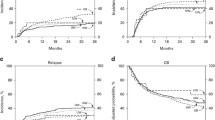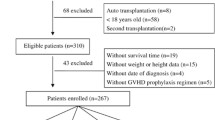Abstract
Bone marrow transplantation is frequently used as a consolidation therapy in patients with haematological malignancies to improve the outcome of these patients. Obese individuals have larger absolute lean body and fat masses than non-obese individuals of the same age, gender and height, which might lead to altered pharmacokinetics of chemotherapeutic agents. Data on the impact of body mass on transplant outcome is conflicting. This study included 331 patients (M, 230; F, 101) with 336 allogeneic transplant episodes from two large teaching hospitals in the West Midlands region in United Kingdom. A total of 105 patients had acute myeloid leukaemia, 83 had non-Hodgkin’s lymphoma, three had myeloma, 21 had Hodgkin’s lymphoma, 34 had acute lymphoblastic leukaemia, 19 had chronic myeloid leukaemia, 22 had chronic lymphocytic leukaemia, 24 had myelodysplasia, seven had T cell non-Hodgkin’s lymphoma, six had aplastic leukaemia and seven had myelofibrosis. At transplantation, 40% (N = 133) of the patients had normal and 60% (N = 198) had high body mass index (BMI) with 14% of the patients being obese (BMI >30). After a median follow-up of 24 months (range, 2–79), the mean overall survival (OS) in patients undergoing allograft with normal BMI was 31 months as compared to 39 with high BMI (p:0.06). The mean progression free survival (PFS) in patients undergoing allograft with normal BMI was 33 months as compared to 38 with high BMI (p = 0.13). Of the patients in the high and obese BMI group, 16% developed acute GvHD with 8% grade III–IV and 28% in the normal BMI group with 14% grade III–IV acute GvHD (p = 0.11). Of the patients in the high BMI group, 17% developed chronic GvHD and 30% of the patients in the normal BMI group (p = 0.09). However, higher infection rates and more days of inpatient stay in the first year post-transplant were observed in the high BMI and obese patients, but there was no difference in ITU admissions. This study shows that high BMI and obesity does not adversely impact on either OS or PFS in patients undergoing allogeneic transplantation for haematological malignancies, but it does have a significant impact on infection rates and hospitalisation of high BMI and obese patients. We recommend that patients with high BMI should not be excluded from allogeneic transplantation; however, good supportive care and careful patient selection on the basis of comorbidity index should be undertaken in order to avoid the risks from the increased rates of infection.

Similar content being viewed by others
References
Coghlin Dickson TM, Kusnierz-Glaz CR, Blume KG et al (1999) Impact of admission body weight and chemotherapy dose adjustment on the outcome of autologous bone marrow transplantation. Biol Blood Marrow Transplant 5:299–305
Hasse J (2007) Pretransplant obesity: a weighty issue affecting transplant candidacy and outcomes. Nutr Clin Pract 22(5):494–504
Meloni G, Proia A, Capria S, Romano A, Trapé G, Trisolini SM, Vignetti M, Mandelli F (2001) Obesity and autologous stem cell transplantation in acute myeloid leukemia. Bone Marrow Transplant 28(4):365–367
Pi-Sunyer FX (1993) Medical hazards of obesity. Ann Intern Med 119:655–660
Janssen I, Katzmarzyk PT, Ross R (2002) Body mass index, waist circumference, and health risk: evidence in support of current National Institutes of Health guidelines. Arch Intern Med 162(18):2074–2079
Must A, Spadano J, Coakley EH, Field AE, Colditz G, Dietz WH (1999) The disease burden associated with overweight and obesity. JAMA 282(16):1523–1529
Navarro WH (2003) Impact of obesity in the setting of high-dose chemotherapy. Bone Marrow Transplant 31(11):961–966
Benn RT (1970) Indices of height and weight as measures of obesity. Br J Prev Soc Med 24:64
Chopra M, Galbraith S, Darnton-Hill I (2002) A global response to a global problem: the epidemic of overnutrition. Bull World Health Organ 80(12):952–958
Fleming DR, Rayens MK, Garrison J (1997) Impact of obesity on allogeneic cell transplant patients: a matched case-controlled study. Am J Med 102:265–268
Clarke B, Engler H (1999) Patients with morbid obesity don't get life-saving bone marrow transplants. Obes Surg 9(1):77–79
Deeg HJ, Seidel K, Bruemmer B et al (1995) Impact of patient weight on non-relapse mortality after marrow transplantation. Bone Marrow Transplant 15:461–468
Deeg HJ, Seidel K, Sullivan KM (1998) Body weight and outcome of hematopoietic stem cell transplantation. Am J Med 104(6):607–608
Dickson TM, Kusnierz-Glaz CR, Blume KG, Negrin RS, Hu WW, Shizuru JA, Johnston LL, Wong RM, Stockerl-Goldstein KE (1999) Impact of admission body weight and chemotherapy dose adjustment on the outcome of autologous bone marrow transplantation. Biol Blood Marrow Transplant 5(5):299–305
Tarella C, Caracciolo D, Gavarotti P, Argentino C, Zallio F, Corradini P, Novero D, Magnani C, Pileri A (2000) Overweight as an adverse prognostic factor for non-Hodgkin's lymphoma patients receiving high-dose chemotherapy and autograft. Bone Marrow Transplant 26(11):1185–1191
Hansen JA, Gooley TA, Martin PJ, Appelbaum F, Chauncey TR, Clift RA, Petersdorf EW, Radich J, Sanders JE, Storb RF, Sullivan KM, Anasetti C (1998) Bone marrow transplants from unrelated donors for patients with chronic myeloid leukemia. N Engl J Med 338(14):962–968
Kyle UG, Chalandon Y, Miralbell R, Karsegard VL, Hans D, Trombetti A, Rizzoli R, Helg C, Pichard C (2005) Longitudinal follow-up of body composition in hematopoietic stem cell transplant patients. Bone Marrow Transplant 35(12):1171–1177
Yañez R, Lamana ML, García-Castro J, Colmenero I, Ramírez M, Bueren JA (2006) Adipose tissue-derived mesenchymal stem cells have in vivo immunosuppressive properties applicable for the control of the graft-versus-host disease. Stem Cells 24(11):2582–2591
Puissant B, Barreau C, Bourin P, Clavel C, Corre J, Bousquet C, Taureau C, Cousin B, Abbal M, Laharrague P, Penicaud L, Casteilla L, Blancher A (2005) Immunomodulatory effect of human adipose tissue-derived adult stem cells: comparison with bone marrow mesenchymal stem cells. Br J Haematol 129(1):118–129
Conflicts of interest
No conflicts of interest to declare
Author information
Authors and Affiliations
Corresponding author
Rights and permissions
About this article
Cite this article
Nikolousis, E., Nagra, S., Paneesha, S. et al. Allogeneic transplant outcomes are not affected by body mass index (BMI) in patients with haematological malignancies. Ann Hematol 89, 1141–1145 (2010). https://doi.org/10.1007/s00277-010-1001-6
Received:
Accepted:
Published:
Issue Date:
DOI: https://doi.org/10.1007/s00277-010-1001-6




